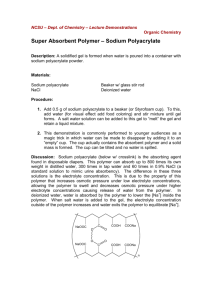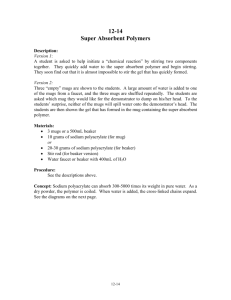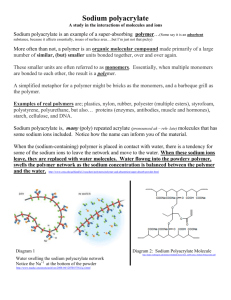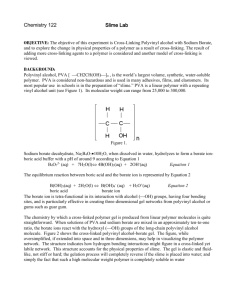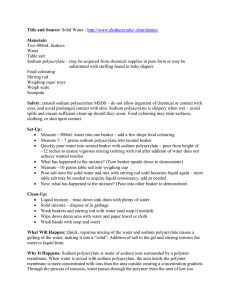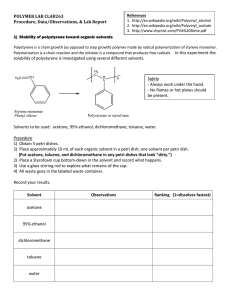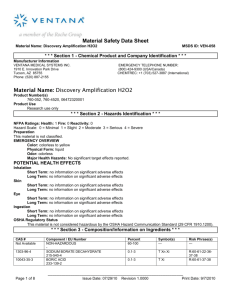E:\Science\structures\polymer day polyacrylate and polyvinyl alcohol
advertisement
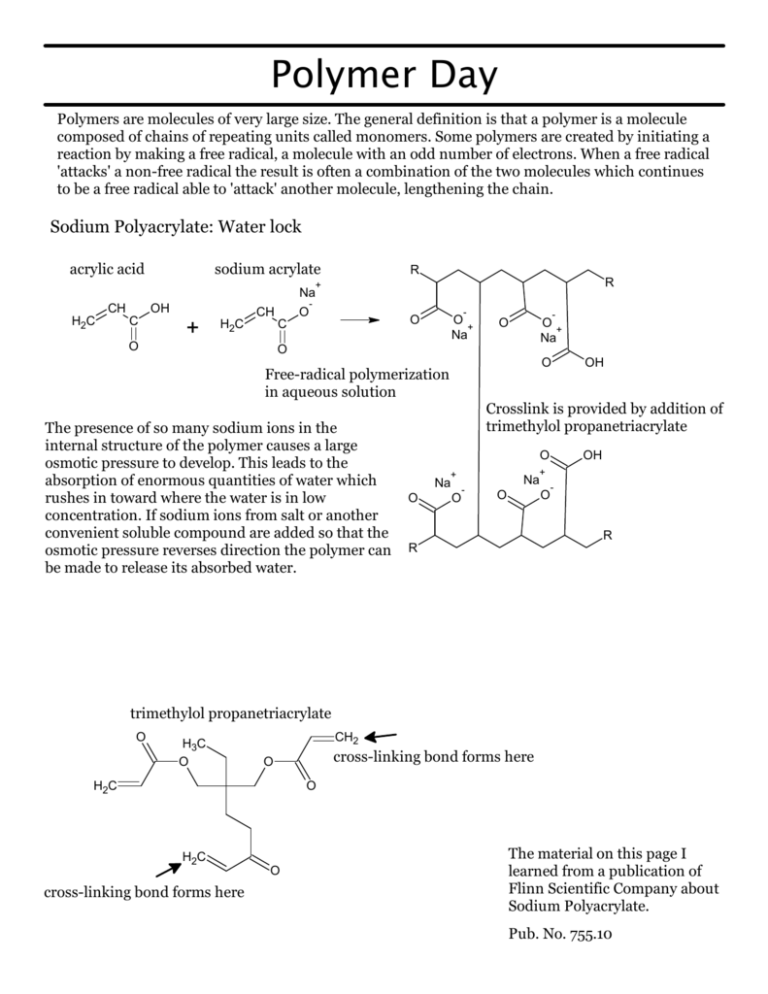
Polymer Day Polymers are molecules of very large size. The general definition is that a polymer is a molecule composed of chains of repeating units called monomers. Some polymers are created by initiating a reaction by making a free radical, a molecule with an odd number of electrons. When a free radical 'attacks' a non-free radical the result is often a combination of the two molecules which continues to be a free radical able to 'attack' another molecule, lengthening the chain. Sodium Polyacrylate: Water lock acrylic acid sodium acrylate R R + Na CH H2C OH C CH + H2C O - O - O C O + Na - O + Na O O O OH Free-radical polymerization in aqueous solution The presence of so many sodium ions in the internal structure of the polymer causes a large osmotic pressure to develop. This leads to the absorption of enormous quantities of water which rushes in toward where the water is in low concentration. If sodium ions from salt or another convenient soluble compound are added so that the osmotic pressure reverses direction the polymer can be made to release its absorbed water. Crosslink is provided by addition of trimethylol propanetriacrylate O + Na O O OH + Na - O O - R R trimethylol propanetriacrylate O H3C O CH2 cross-linking bond forms here O H2C O H2C O cross-linking bond forms here The material on this page I learned from a publication of Flinn Scientific Company about Sodium Polyacrylate. Pub. No. 755.10 Poly-vinyl Alcohol: Elmer's Glue HO 3 H3C 1 OH HO OH OH HO OH HO CH3 1 2 2 OH OH OH OH The usual sequence puts an "OH" every 3rd carbon atom. This is called a 1,3-diol structure. OH HO Every so often there is a 1 - 2 sequence which allows borate ions to bind and cross-link the long chains of the polymer. This is called a 1,2-diol. When Borax (Na2B4O7*10H2O) dissolves in water it creates a boric acid-borate ion buffer with a pH of 9.2. B(OH)3 + 2 H2O --> B(OH4)- + H3O+ Boric Acid Borate ion In aqueous solution this polymer is very soluble due to the large number of "OH" groups. It is also very viscous because the "OH" groups can hydrogen-bond--a very strong form of intermolecular attractive force. Think of the flow properties of Elmer's glue and you know what this is like. The borate ion can bind covalently to the 1,2 sequence of "OH" groups (1,2-diol) in poly-vinyl alcohol. These cross-links cause the spaghetti-like molecules to flow much less freely past each other. This causes a gel to form that we affectionately call "Slime" or "Glurch". This is illustrated R R R below. OH HO B - OH + R OH R B R OH OH O O R R - + 2H3O+ R R O O R R This structure shows the cross-link between chains of poly-vinyl alcohol. With all the random links between chains the chains now can't flow past each other as quickly. Think about overcooked spaghetti and you have the idea. This makes the poly-vinyl alcohol into a gel with very slow flow. The amount of water included in a mixture of glue, water, and 4% sodium borate solution determines the properties of the gel. With only a little water the gel is very 'hard' and bouncy. With a lot of water it's very gooey and possibly more fun to play with. The material on this page I learned from a publication of MIT called the Chemistry Outreach Program. Further information about Glurch (aka Gluep) can be found at the Macrogalleria of Polymers: http://web.mit.edu/chemistry http://www.pslc.ws/macrog/ polypro/exp/gluep.htm or http://www.pslc.ws/macrog/ activity/ball/lev3/level3.htm
